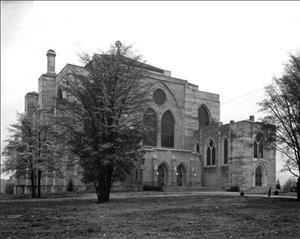In 1930, St. Mark's Episcopal Cathedral, located at 1245 10th Avenue E in Seattle's Capitol Hill neighborhood, opens. The cathedral is dedicated on April 25, 1931. Saint Mark's is the Cathedral church of the Diocese of Olympia, part of the Episcopal Church.
The neo-Byzantine structure was designed by the San Francisco firm of Bakewell and Brown, but never finished as designed because of the great economies imposed by the Great Depression. As the church history describes it, "This 'Holy Box,' as it is affectionately called, represents what could be done with the money which was available. At the time of the dedication, $250,000 was still owed to the St. Louis bankers who financed the construction" (www.saintmarks.org).
From 1931 until 1941, the finances continued to plummet, and in 1941 the bank foreclosed and the building was put up for sale. It remained vacant until 1943, when it was leased to the U. S. Army.
In 1944, the cathedral again opened for worship, the results of various efforts to raise funds and to start over. The Reverend Richard Watson was persuaded to leave his parish in Houston to become Dean of St. Mark’s. Fundraising was a focus. Efforts included a banquet hosted by the Teamsters leader Dave Beck (1894-1993) and brewery entrepreneur Emil Sick (1894-1964). The debt was finally paid off and the mortgage was burned before the altar on Palm Sunday, 1947.
In 1952, Dean John C. Leffler (1900-1987) arrived. The Right Reverend John C. Leffler was the dean of St. Mark's Episcopal Cathedral from 1952 to 1971. He took over a "dirty, grimy, dismal church" (The Seattle Times) that had been lost in foreclosure and transformed it into the center of a thriving religious and social community. St. Mark's gained a nationwide reputation for its liturgical music, which was broadcast weekly on the radio. Dean Leffler was vocal in many controversial issues and he was an opponent of the Vietnam War.
In the decades since then, St. Mark's Episcopal Cathedral has been a vibrant and central part of the Capitol Hill community. In 2001, St. Mark's congregation had a membership numbering more than 2,000 people from diverse communities.

